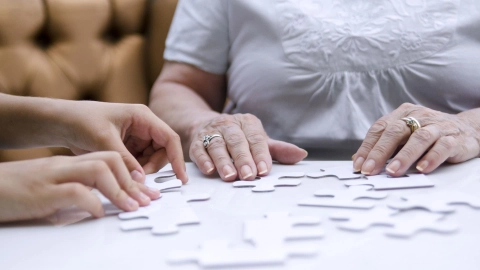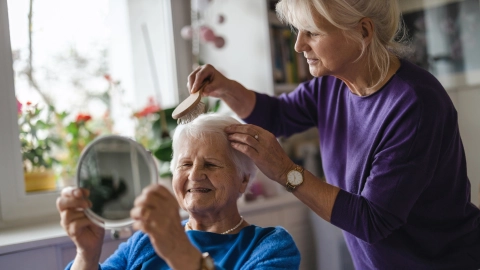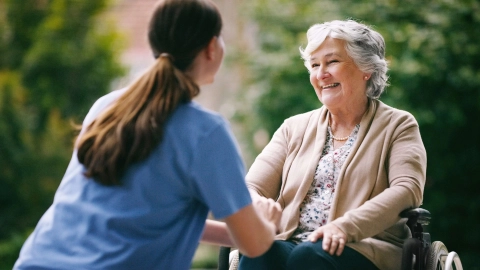Care Preventing abuse in a home care setting
Abuse and aggression by family caregivers, i.e. those providing care to a loved one at home is an important topic. It is not always the result of bad intentions. Read more here about the causes and different forms of abuse and aggression and how these can be prevented.
At a glance
- Abuse of a person in need of care refers to any action or failure to respond that harms the care recipient, adds to their suffering, or violates their right to self-determination – either physically or psychologically.
- Abuse can occur when the care recipient is being cared for at home, and may affect both care recipients and caregivers.
- Abuse has many causes and can take many forms.
- People with dementia and other cognitive impairments are at an increased risk of experiencing abuse. They may show aggressive behavior due to their illness.
- There are various strategies that may help prevent abuse in care situations, and there are ways of getting help and advice.

What does “abuse in care” mean?
Abuse is something that can occur in a care setting. In this context, abuse refers to any action or failure to respond that harms a care recipient, adds to their suffering, or violates their right to self-determination. Not every act that can be described as abuse in care is legally prohibited. Nonetheless, these acts can be physically and psychologically harmful to health over the long term.
Official statistics do not show how many care recipients experience abuse, or how often. However, the findings from various studies show that it is a common problem – both in residential care facilities and home care settings, as family caregivers and staff employed by outpatient care services may sometimes act in an abusive way too.
There are different reasons for abuse in care settings. These include criminal behavior by people who deliberately exploit the helplessness of care recipients in order to exert power or for their own financial gain. However, abuse can have other reasons too, and may be carried out by people who are genuine in their desire to care for the care recipient. This can occur, for example, as a result of being over-stressed, careless or simply unaware.
In addition, family caregivers can themselves experience aggression and abuse at the hands of care recipients while providing care. This can, in turn, cause caregivers to be aggressive and abusive towards care recipients.
People with dementia and other cognitive impairments are at an increased risk of experiencing aggression and abuse. Firstly, as their illness progresses, they are often unable to defend themselves or make themselves understood. Secondly, certain challenging behaviors, such as shouting and hitting out, may be part of their illness.
To prevent abuse in a home care setting, it is important for the loved ones who are acting as caregivers to find out what could lead to, or has actually led to, abuse in their own situation. Support from external parties is sometimes also helpful in this respect.
How can abuse manifest itself in a home care setting?
Not every act that can be described as abuse in care is legally prohibited. Nonetheless, these acts can be physically and psychologically harmful to health over the long term.
Psychological abuse
Psychological abuse is a common problem in care settings.
It includes, for example:
- shouting
- exerting psychological pressure
- disrespectful and humiliating behavior, such as insults and put-downs, entering a room without knocking, avoiding eye contact, talking to someone or treating them like a child, embarrassing them, talking over their head, and not taking their needs, feelings or pain seriously
Inadequate care
The objective of good care is to help the care recipient in such a way that they can lead a life that is as independent and self-determined as possible – despite all their impairments. Abuse can also mean infantilizing and neglecting the care recipient. This includes, for example:
- forceful spoon-feeding to speed things up
- making decisions about their everyday life, their activities and contacts
- withholding information and opening letters without permission
- talking about, and deciding on, medical and care measures with the doctor, over the head of the care recipient
- taking care measures against the person’s will – for example, forcing the care recipient to use incontinence pants to avoid having to take them to the toilet
- refusing help or letting the person wait a long time for assistance, sometimes in vital areas of life, such as providing food and drink, clean clothing, proper hygiene, and adequate exercise
Physical abuse
Hitting is not the only type of physical abuse. Gripping tightly, giving medication incorrectly, pinching, hair pulling, rough treatment, washing with water that is too hot or too cold, and changing dressings carelessly are also forms of abuse.
Sexual abuse
Care recipients may become victims of sexual abuse. Even very elderly people and people with severe mental and physical impairments can be affected. This includes not only sexual assault and rape but also, for example, forced nudity, unwanted or forced touching and use of sexual innuendo and language.
Financial exploitation
Care recipients’ vulnerable situations are sometimes exploited, for example by other people making unauthorized decisions about their property, persuading them to gift them money or stealing their valuables.
Even if legal guardians or authorized agents have been appointed, they should not have unrestricted access to the personal property of the care recipient.
Restraining measures
Measures may be taken to restrict the freedom of movement of care recipients. This is sometimes done with the intention of protecting them from falling or having an accident, but also when caregivers have so much to do that they cannot cope.
These measures include, for example:
- strapping a person to their bed or wheelchair or using bed rails to prevent them from getting up
- locking care recipients in a room or taking away clothing and aids such as spectacles, prostheses and walking sticks
- giving medication that is unwanted or has not been prescribed in order to make the person tired so that they do not want to move about as much
All of these measures are considered types of restraint. They are dangerous and are not permitted if the care recipient or their legal guardian has not given their consent.
Abuse of caregivers
Professional carers and family caregivers who are caring for loved ones at home may also be abused by care recipients. For example, they may be:
- verbally abused and insulted
- pinched and hit
- sexually assaulted
In some cases, the assaults can be explained by the care recipient’s illness or condition.
What are the reasons for abuse in a care setting?
There are as many reasons as there are types of abuse. Multiple factors often combine.
Personal and interpersonal reasons
Some people are, by nature, easily irritated and tense. However, other personal reasons can also play a part – for example, if someone has experienced abuse themselves, or if the relationship was already strained before the need for care arose. The caregiver role may have been taken on due to a feeling of obligation or for financial reasons. Excessive alcohol consumption by the caregiver can also increase the likelihood of abusive behavior.
Sometimes, a care situation also changes interpersonal relationships – for example, because roles change and parents who have always valued their independence are now dependent on the help of their (adult) children. When people are in need of care, feelings such as helplessness, shame or distress may also be the reason why they behave aggressively.
Difficulty coping
Many loved ones find caring for a family member to be stressful, both physically and mentally. Many caregivers feel that the entire burden of care rests on their shoulders alone. Moreover, the behavior of care recipients can be very challenging. If caregivers are not in a position to accurately assess the situation and the behavior, they may react inappropriately.
Ignorance
Not all caregivers are aware that certain actions are inappropriate. Many caregivers do not know that measures that prevent care recipients from getting up and moving about count as restraint, and that there are effective alternatives to such methods. A lack of knowledge about clinical pictures and the evolution of illnesses can also make abuse by family caregivers more likely.
Illnesses
Health problems suffered by caregivers can lead to excessive aggression – for example alcohol dependency, mental illnesses or chronic pain.
How can caregivers prevent abuse?
Not every inappropriate action is the result of bad intentions. Irritation, frustration, anger, powerlessness and helplessness are normal feelings. It’s okay to have these feelings. On the other hands, methods and support options should be used to avoid abuse. It is important to try to find the specific reasons for the abuse before determining the right solution for each specific situation.
Identify and understand
Care recipients have the same rights as everyone else. These include, for example, the right to self-determination and safety. Even if they are being cared for at home, it is important to regularly reflect on how these rights can best be protected.
Challenging and aggressive behavior may also be explained by illnesses such as dementia. It may help to try to keep this in mind.
This does not have to be done by caregivers on their own – training courses can help people learn better ways of dealing with difficult situations in care. Doctors are a resource that can be drawn on for advice and information about what could be causing particular behaviors. Help is also available from care advice centers and from self-help groups.
Dealing with one’s own aggression
Better ways of dealing with aggression can be learned. To do so, the reasons for the aggression must first be identified. Once a caregiver understands the reasons for their own aggression, they can choose to react differently next time.
In the short term, talking about one’s frustration can help – to friends, in self-help groups, or anonymously on a phone hotline such as that operated by Telefonseelsorge. In the longer term, you may want to consider whether you want to access support from a care service, for example in specific difficult situations. Care advice centers can explain specific options and provide support with any funding issues.
Alternatives to restraint
Studies do not indicate that restraining measures offer effective protection from falls and accidents. Rather, they tend to increase the risk of injury, and they can make people with dementia, for example, more agitated.
In many cases, effective alternatives are available. The Centre for Quality in Care (Zentrum für Qualität in der Pflege) explains how restraint can be avoided in different situations, for example, by preventing falls and mitigating hazards in other ways.
Support and respite
Aggression and abuse can occur when someone is unable to cope. The long-term care insurance scheme provides various services that can provide respite for loved ones who are acting as caregivers. Support options are also available from charities and self-help groups. In many cities and regions, dementia networks help with care at home. Care advice centers and family doctors can advise on what support is available locally.
The guide on avoiding abuse (“Gewalt vorbeugen”) published by the Center for Quality in Care (Zentrum für Qualität in der Pflege) provides more advice on dealing with aggression and preventing abuse (in German).
Where to get help
If care recipients or those providing care to a loved one at home are affected by abuse in any way, it is advisable to address the situation and get help. Even if you are hesitant because you may be unsure whether what you are experiencing is abuse or because you are worried, depend on the other person financially or are ashamed, there are ways of improving the situation.
If you yourself are a victim of abuse:
Try to talk to the person concerned. Make it clear that you find the inappropriate behavior unacceptable. If you are not confident about doing this on your own, you can turn to someone you trust or contact your doctor or an advice center specializing in abuse.
If an employee of an outpatient care service behaves inappropriately or abusively towards you, it is important to report this to a manager at the care service. If you do not trust the care service enough to do this, you can also make an anonymous report, for example, to the care insurance fund, the Medical Review Board (Medizinischer Dienst) or local complaints office.
If you have witnessed abuse
Have you witnessed abuse against a care recipient? If so, talk to the care recipient about what to do next, if possible, and then take the steps outlined above if necessary.
Outsiders can also get advice on the right thing to do from the relevant advice centers.
Contacting the police
If harm has been done to a care recipient, the police should be contacted immediately. The police can be phoned at any time on the emergency number 110. In such cases, it may also be useful to seek support from one’s circle of relatives and friends or from an advice center.
How can I identify abuse in a care situation?
Abuse of care recipients is not always easy to identify. Signs such as bruises and injuries, changes in behavior, as well as anxiety and aggression can also be caused by other things, such as falls or illness. Those affected are sometimes no longer able to express themselves clearly or they may remain silent because of fear or shame.
As family caregivers and care recipients do not always talk openly about abuse, it is important to take a closer look and address the subject if abuse is suspected. In particular, people from within the circle of relatives, friends and neighbors, as well as care services and family doctors can have an important role to play in this.
Even if it is uncomfortable, the situation should be addressed – with specifics and without making accusations, if possible. It is helpful to offer support and to refer those involved to the regional assistance system. It can also be a good idea to pass the phone number of the person concerned on to an advice center, after first getting their permission to do so. This depends upon the person being willing to talk about these problems and to accept help.
The “Report Violence” (Befund: Gewalt) portal (in German) of Fulda University lists possible indicators of abuse in care, and makes recommendations about documentation. It also explains how to approach those affected and how to offer help.
What is my first port of call for advice?
The following helplines are available to everyone involved – care recipients, caregivers, loved ones, friends and acquaintances.
Crisis hotline for people experiencing conflict or abuse in care: The website of the Center for Quality in Care foundation (Zentrum für Qualität in der Pflege) shows which crisis line is currently available at any time of day.
“Violence Against Women – Support for Women in Need” (Gewalt gegen Frauen – Unterstützung für Frauen in Not) helpline: 116 016 (24 hours a day in English, German and 17 other languages)
“Violence Against Men” (Gewalt an Männern) helpline: 0800 1239900 (Monday to Thursday 8 a.m. to 8 p.m. Friday 8 a.m. to 3 p.m.)
“Nummer gegen Kummer” helpline for children and adolescents: 116 111 (Monday to Saturday 2 p.m. to 8 p.m.)
“Care Options” (Wege zur Pflege) care helpline operated by the Federal Ministry of Family Affairs: 030 20 17 91 31 (Monday to Thursday 9 a.m. to 4 p.m.)
- Bundesministerium für Familie, Senioren, Frauen und Jugend. Kriminalitäts- und Gewalterfahrungen im Leben älterer Menschen. Zusammenfassung wesentlicher Ergebnisse einer Studie zu Gefährdungen älterer und pflegebedürftiger Menschen. Berlin 2012.
- Hochschule Fulda. Website „Befund: Gewalt“. Aufgerufen am 14.03.2024.
- Initiative zur Begrenzung freiheitseinschränkender Maßnahmen in der Altenpflege. Mehr Freiheit wagen! Update 2015.
- Zentrum für Qualität in der Pflege. Gewalt vorbeugen. Praxistipps für den Pflegealltag. 5., leicht geänderte Auflage, Berlin 2022.
- Zentrum für Qualität in der Pflege. ZQP-Analyse. Aggression und Gewalt in der informellen Pflege. Berlin 2018.
- Zentrum für Qualität in der Pflege. Magazin ZQP diskurs. "Gewalt in der Pflege". Ausgabe 2022.
- Zentrum für Qualität in der Pflege. ZQP-Report. Gewaltprävention in der Pflege. Berlin 2017.
Reviewed by the Center for Quality in Care (Zentrum Qualität in der Pflege, ZQP).
As at:





